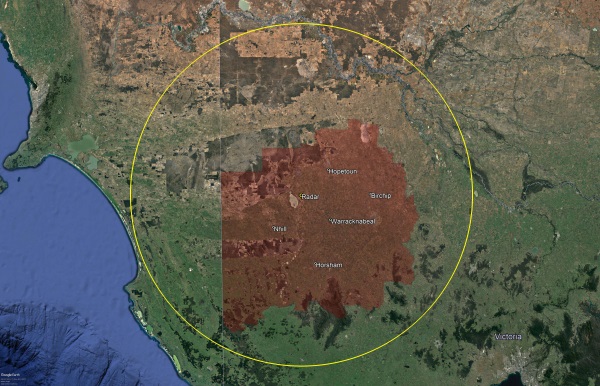The people of north-west Victoria are a step closer to having real-time weather information at their disposal following today’s announcement of the site for a brand new weather radar in the Wimmera.
The new installation will be built on a site two kilometres west of Pullut, and about eleven kilometres south of the town of Rainbow, and it was chosen after an extensive and detailed process to identify a location that would best serve both the Wimmera region and the wider Australian weather radar network.
It will encompass an area of 200 kilometres in every direction, filling the gap that currently exists between the radar stations at Mildura, Mt Gambier and Melbourne.
Above - An artist’s impression of the structure that will house the radar, and the map below shows the areas that will benefit from this new installation.
The Bureau of Meteorology’s Victorian State Manager, Dr Andrew Tupper, said getting the project to this stage has been the result of great cooperation between the local community and the Victorian State government.
"The Australian Government, through the Bureau of Meteorology and the Victorian Government, represented by the Department of Economic Development, Jobs, Transport and Resources, have been working closely with the Wimmera Development Association on this important infrastructure project for the region," Dr Tupper said.
"As the radar is such a significant project, it has been vital for all parties to get the details right to ensure that it provides the maximum benefit, particularly for the region’s primary producers who depend so much on accurate rainfall forecasts," he said.
"The data available through the radar will help growers to make informed choices about harvesting, tillage and the use of chemicals and fertilisers."
Other benefits of the radar include enhanced short-term rainfall forecasts and the provision of additional information to Bureau of Meteorology experts during severe weather events.
Dual polarised doppler radars provide one of the best tools for observing real-time rainfall, storms and even debris in the atmosphere, across large areas.
Radars use electromagnetic waves similar to wireless computer networks and mobile phones to detect rain drops, hail or snow; Doppler radars can also measure wind by detecting the speed of movement of the water that they encounter.
The state-of-the-art dual polarised doppler radar is now under construction in Germany and is due to begin operating in mid-2020, if not sooner.

|






